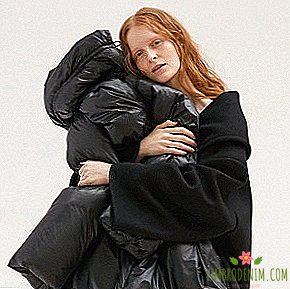What men want: Dad's style, gangsters in skirts and corporal fascism
"Some of us need shorts Some people like kilts, but for sure, the overwhelming majority are disgusting trousers. Someone dreams of lighter materials and the absence of shoulder pads, someone - of bright colors. And everyone definitely hates these suffocating, narrow collars. "These lines are excerpts from the manifesto of the men's movement of the Men's Dress Reform Party, published back in 1929.
In fact, the ultimate goal of this organization was to increase the level of hygiene and improve the psychological climate in society. However, first of all, representatives of the party, among whom was a psychologist, the author of the book "The Psychology of Clothing" and the term "great male renunciation" John Flugel, fought for the liberalization and abolition of male wardrobe. The party's program was exhaustively explained by the thesis "" no "costume dictatorship," yes "- the diversity and freedom of expression."

Since then, nearly a century has passed, women have managed to plunder men's wardrobes, assign the status of gender neutral things to trousers and shirts, and generally win almost every conceivable right in the field of fashion. But bad luck, the pink leggings of Shayi Labaaf, which many would envy, are still perceived by the majority as an indisputable marker of his rebellious spirit, and bus drivers in France and schoolchildren in Britain have to organize strikes so that they do not ostracize for wearing a skirt in the heat .
Amazing somersaults that men's fashion made in the course of the development of civilization are still poorly amenable to logical comprehension. The history of mankind is littered with examples of opposition between eccentrics and puritans who fought and fight in an endless battle for what is considered the standard of masculinity. For example, if in the 1970s David Bowie shocked the public with his make-up and fancy outfits, then in England of the Regency era without these attributes he would hardly have been accepted in high society. It is worth remembering that the strict gender division of clothing is typical mainly for Western cultures of the last two centuries, whereas in the East (and in antiquity) men's dress and skirt were never associated with the topic of sexual identity.
The main sociocultural paradox today is that in the 21st century, men have to win for themselves the fashion privileges that women have had since the middle of the 20th century. Our contemporaries have many serious and unresolved problems in the field of fashion: there is the lack of a harmonious movement for bodypositive and diversity, and the total unconscious devaluation of those who are seriously interested in beauty and fashion, not to mention the fact that men's right to emphasize their sexuality with the help of clothes, as women have been doing for all ages, is still not legitimized.


However, the main focus of the struggle at the moment is focused on returning skirts, dresses, ruffles and crepe georgette to the men's wardrobe so that the degree of masculinity inside the chiffonier with things does not fall to critical levels. Quoting young rapper Young Thug, who demonstrates how to wear a skirt from the women's collection over your favorite jeans in the recent Calvin Klein campaign: "You can be a gangster in a dress and baggy pants." Interesting metamorphosis also occurs in the field of male power dressing. More recently, a huge hooded gray wool suit was associated with power and domination; it was worn by the most successful businessmen and politicians who clearly demonstrated to the world who is the most important. But today, when the financial flows unfolded from Wall Street towards Silicon Valley, and the rapidly advancing future is under the jurisdiction of the inhabitants of San Francisco and the surrounding area, the uniform of a successful and influential person was a modest set of T-shirts, jeans and sneakers. No wonder Alexander Robike, who works in the field of creating artificial intelligence, became one of the central heroes of the Yves Saint Laurent Y advertising campaign. So getting rid of costume dictatorship is quite possible to equate to the victory of women over corsets and tures. John Flugel, who was discussed at the very beginning, believed that the man, having taken the tacit obligation to wear boring, inconspicuous clothes that look like uniforms, agreed that from now on he would perform an exclusively practical function for society , well, or a breadwinner, if you think in the format of Soviet gender mythology. So, he had to give up any claims to be the object of admiration and inspiration.


It is all the more interesting to watch how confidently men today are stepping onto the primordially female territory and setting up a fashion industry for themselves. Five or ten years ago, in order to become visible to the fashion community, men had to try on the eccentric masks of the Pitti Uomo characters. In 2017, on the contrary, the whole fashion revolves around the male world, and sometimes in its most traditional manifestations.
For example, in the latest collections, the image of the father has become an inspiration for fashion brands. The main trendsetter here, as you might guess, is Gvasalia: both at the Balenciaga show and in the Vetements lookbook, the age uncles in very recognizably stylized ensembles (the term “deadcore” fit in right here), hung with children as if expensive accessories, became central figures of the fashion narrative. The appearance of such types is a significant moment: while the podium and advertising images were captured by beautiful older women, unconventional middle-aged men in the fashionable space are still catastrophically low.
However, the concept of "plus-size" is completely unfamiliar to the current men's fashion. As it turns out, many generations of men were forced to exist in the realities of real corporal fascism. If you think about it, by and large, ideas about male beauty have not changed since the days of ancient Greece: to be considered attractive, a man must be tall and athletic. In fact, the standards faltered a bit only once, when in the 90s a subtle, almost teenage body type came into fashion. The same mode of chanting of a very thin or over-muscular male body with classical proportions reigns in the fashion industry to this day: the conditional Raf Simons is the first to admire, the second is the conditional Tom Ford, the third has not yet been given.
In general, the formation of new men's fashion is still in the bud, and, as usual in troubled times, in this segment there is now quite a lot of chaos and confusion. What language and, most importantly, what to talk about with men today, do not understand not only reputable men's glossy magazines, especially Russian-speaking, long ago turned into a mouthpiece of intolerance and chauvinism, but also big, traditional brands. Fever and Ermenegildo Zegna, where Stefano Pilati left, and Brioni, where over the past year they managed to hire lightning fast and just as lightning fast to fire instagram and street style star Justin O'Shea, and Berluti, with whom it is not at all clear what happens. But everyone will soon have to find out from each other, where, in our unconscious, is a clear statement that a woman in a men's suit is necessarily sexy and her feminine qualities are emphasized with such clothes, and the man in the skirt is definitely not a man. And why is this just a stereotype.
Photo: Fei Fei Yang, Wei Hung Chen, Chin Mens





